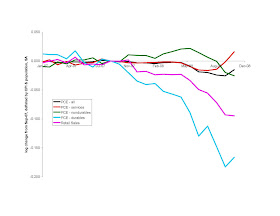In most cases, a homebuyer takes out a mortgage that covers only part of the value of the house he’s buying. In other words, the house a person buys is worth more than the mortgage he owes on it. This means that in the event of borrower delinquency, the lender can, in most cases, obtain his full principal by foreclosing on the house and selling it to a new purchaser.
However, housing prices have fallen dramatically since 2006. By 2008, about 12 million mortgages were “under water” – meaning that market value of the house had fallen below the amount owed on the mortgage. Because of the low resale values, foreclosing on any of those homes will not yield lenders their entire principal; lenders in those cases must rely on the good behavior of the borrowers.
Officials at the Federal Reserve, the United States Treasury, the F.D.I.C., Fannie Mae (most recently, its “Early Workout” program) and Freddie Mac have encouraged lenders in such cases to “modify” mortgages – that is, to accept a stream of payments from the borrowers that is different from the amounts promised when the mortgages were initially signed. In particular, these “modification programs” encourage lenders to reduce mortgage payments so that each borrower’s housing payments (including principal, interest, taxes and insurance) are 38 percent of the borrower’s gross income. The payments are to be reduced for the next five years, or when the mortgage is paid off (whichever comes first).
Of course, a borrower cannot be harmed by the opportunity to have his mortgage payment reduced. But what is economically noteworthy is that the amount of the payment reduction depends on the borrower’s income – the less he or she earns, the more the payment is reduced. For example, a borrower whose annual family income is $100,000 can have her housing payments reduced to $38,000 per year, whereas a borrower whose annual income is $50,000 can have his payments reduced to $19,000 per year.
One implication of the mortgage modification rules is that a family that earns $50,000 less in the year prior to their modification stands to save $19,000 per year for the following five years – or a total of $95,000 on its housing payments! Those are 95,000 reasons to hesitate when looking for a new job, when wrapping up a maternity or paternity leave, or when confronting other job transition situations.
I do not expect every adult among those in the 12 million underwater households to be without a job because of the modification rules. Although modification professionals have specialized in educating homeowners about their modification options, many homeowners probably do not fully understand the mortgage consequences of their earning decisions. Nobody knows the exact numbers, but, even if 90 percent of homeowners were oblivious or uninterested in their modification options, that would leave over a million households that were aware. One million plus workers would make a large dent in the employment statistics.
My previous post reminded readers that productivity has been rising and employment falling in this recession. If approximately one million workers realized that earning income in 2008 was not in their financial interest – and acted on this realization – their actions would have the effect of significantly reducing aggregate employment and hours. As businesses operated with less labor, labor productivity would rise. Maybe the housing crash and mortgage modification that followed have something to do the recession of 2008.










